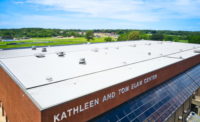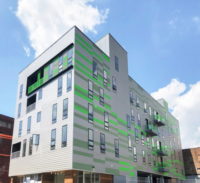Four-Year Roofing Project Touches Down




Dallas Love Field Airport has developed more in its lifetime than one may think. Commissioned during World War I, when the top speed of even the fastest aircraft barely exceeded 100 miles per hour, the airport was little more than a grass landing strip. After more than 85 years in service, Love Field was designated as a Texas State Historical Site in 2003.
The airport greeted the 21st Century with the Love Field Modernization Program, the largest and most ambitious construction effort since its establishment. The airport was extensively renovated and expanded with a design that maintained the basics for which Love Field is known: passenger convenience, operational efficiency and maintainability.
The $519 million project involved a complete terminal renovation and expansion, the addition of new concourses, a larger baggage claim to accommodate future demand levels and a new ticketing wing to significantly cut down on lines. The new design, developed by Corgan Architects, incorporates tall open ceilings and curtainwall, allowing for an abundance of natural light to shine in. The entrance to the airport was also re-designed and expanded to allow for a more modern appearance.
Chamberlin Roofing & Waterproofing was selected by General Contractor Hensel Phelps as the roofing contractor for this project. Chamberlin re-roofed the existing main terminal and installed a new roofing system on the expansion of the main terminal, new baggage claim, new ticketing wing and new concourses. In total, 450,000 square feet of a torch-applied Soprema two-ply modified bitumen roofing system was installed.
Chamberlin also installed a 45,000 square-foot GAF PVC roof on the main canopy at the airport entrance as well as a 40,000 square-foot Firestone TPO roof system on a roadway canopy. Chamberlin’s scope of work also included the installation of 12,000 lineal feet of Hickman aluminum coping on all of the roofs combined.
A 10-man crew worked for four years to complete this tremendous project on time and with no safety incidents. Due to airport traffic and safety concerns for pedestrians, continuous accessibility to different roof areas was challenging.
When re-roofing some areas, such as over boarding gates or TSA office, the crew only had a 24 to 48 hour time frame to tear off the roof and replace it. These areas could only be closed to passengers for that brief amount of time and were otherwise high traffic areas, so keeping them watertight was imperative.
Chamberlin met this challenge with proactive communication, a clearly laid out installation plan and accelerated production. An unexpected circumstance encountered on one roof required some innovative thinking from Chamberlin. The roof deck on the baggage claim facility was not properly sloped for drainage, and Chamberlin recognized this would cause waterpooling issues on the roof.
Chamberlin redesigned the roof installation on the spot to solve this issue without having to replace the roof deck. After conferring with Hensel Phelps, they began adding extra insulation to fill in the flat areas and raise them to meet the necessary slope. Some areas required up to six inches of additional insulation. After Chamberlin installed the two-ply Soprema modified bitumen roof system over the insulation, the finished product resulted in a roof that efficiently and effectively drains water. This was all done without interrupting the overall production schedule of the project.
Looking for a reprint of this article?
From high-res PDFs to custom plaques, order your copy today!





_Ft-Kingspan-Light--Air-GridSpan-FRP-Skylights_Courtesy-of-Kingspan-Light--Air.jpg?height=200&t=1719832834&width=200)

